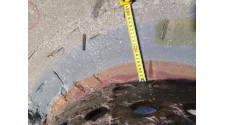
Steven Benbow, James Wilson, Richard Metcalfe and Jarmo Lehikoinen of the Radiation and Nuclear Safety Authority in Finland (STUK) have recently had the results of a study into bentonite reactive transport modelling approaches published in Clay Minerals.
The study considers approaches to simulating cation-exchange and kinetic mineral reactions. These processes can potentially lead to mineral alteration when bentonite clay in an Engineered Barrier System (EBS) of a radioactive waste repository interacts with in situ groundwaters. Alteration of the smectite component of the clay can lead to a loss of desired material characteristics, such as its ability to swell, which are often required to satisfy performance criteria. Realistic modelling of these reaction processes is therefore important in demonstrating confidence that engineering materials will continue to perform as required over long performance assessment timescales (105-106 years are often considered by numerical models).
Cation-exchange and kinetic reactions of a mineral’s framework will occur simultaneously, and so modelling should take a coupled approach to representing them. Traditionally however, modelling has sometimes ignored this coupling, focussing only on the reaction that is deemed most relevant to the application. For short-term modelling such as simulation of laboratory experiments, cation-exchange is often the focus because it is much more rapid than reaction of a clay’s crystal framework. For longer-term modelling, such as applications to natural analogues, cumulative effects of slower reactions of the crystal framework might be assumed to dominate. The approach has the benefit of simplicity, but fails to represent the interplay between the two types of reaction and has the disadvantage that a single model cannot be used to represent both the short- and long-term alteration of the clay, which is sometimes necessary if the ambition is to upscale experimental results to performance assessment timescales. Other approaches that do attempt to couple the two types of reaction tend to link the kinetic mineral dissolution / precipitation process to a single end member in the set of cation-exchanger minerals. For example, it might be assumed that rates of montmorillonite dissolution and precipitation, which control the number of ‘exchange sites’ that are available for cation exchange, can be determined by the Na-montmorillonite end member. This end member might dominate initially and so the approximation may be reasonable during the early stages of evolution, but other end members such as Ca‑montmorillonite may dominate later in the evolution, making the approximation that kinetic rates of dissolution depend only on Na-montmorillonite less valid at later times.
The article presents approaches for fully coupling the two process. It is demonstrated that unrealistic behaviour can emerge from models if the coupling is not represented appropriately, whereby under-saturation of a single cation-exchange end member in an intruding porewater can lead to complete dissolution of the montmorillonite component of the clay. A proposed approach for handling the coupling is presented that determines the saturation of the cation-exchange end members in the dissolution processes in terms their ‘common component’, e.g. in terms of the common montmorillonite structure in Na- and Ca‑montmorillonite, and demonstrates that more realistic evolution is observed when this method of coupling is used. The approach is consistent with historically-proposed approaches in stability analysis of montmorillonite.
The original work described in the article was financed by STUK, the Radiation and Nuclear Safety Authority in Finland, under framework contract 8/Y40021/2013. The views and conclusions presented are those of the authors and do not necessarily represent the official position of STUK.
Lead Image: Iron-bentonite interaction observed during sampling of FEBEX in situ test (photograph presented by University of Bern at FEBEX partner meeting, September 2015; F. Kober, pers. comm. 2015). Taken from Wilson J (2017). FEBEX-DP: Geochemical Modelling of Iron-Bentonite Interactions. Quintessa’s contribution on behalf of RWM. QRS-1713A-R3, V1.3.